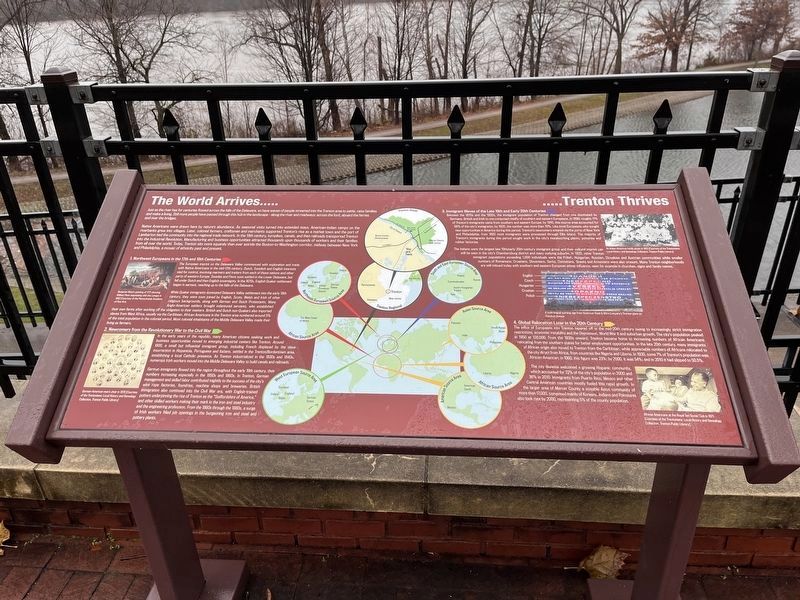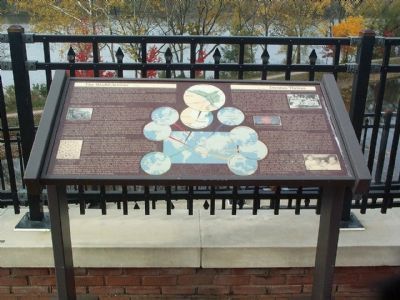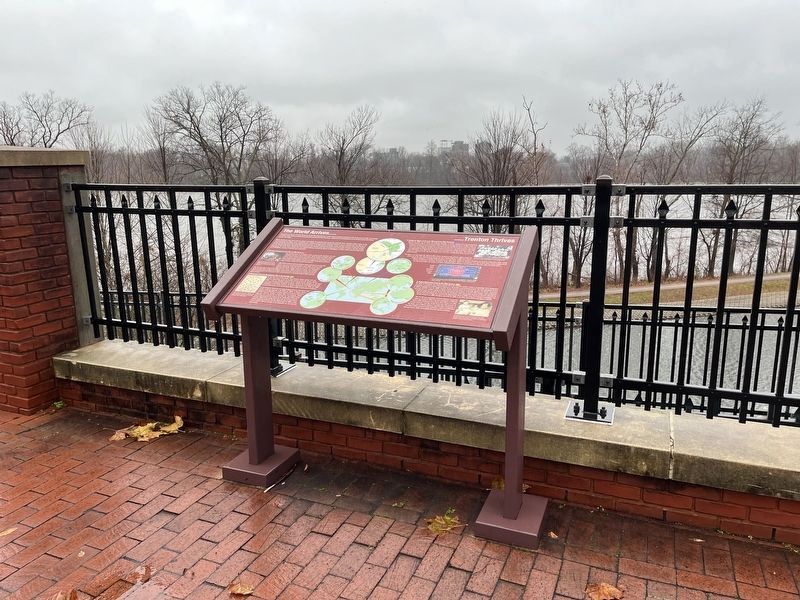South Trenton in Mercer County, New Jersey — The American Northeast (Mid-Atlantic)
The World Arrives.....
.....Trenton Thrives
Just as the river has for centuries flowed across the falls of the Delaware, so have waves of people streamed into the Trenton area to settle, raise families and make a living. Still more people have passed through this hub in the landscape – along the river and roadways, across the ford, aboard ferries and over bridges.
Native Americans were drawn here by nature’s abundance. As seasonal visits turned into extended stays, American-Indian camps on the riverbanks grew into villages. Later, colonial farmers, craftsmen and merchants supported Trenton’s rise as a market town and the port of Lamberton tied the community into the regional trade network. In the 19th century, turnpikes, canals and then railroads transported Trenton into the Industrial Revolution. Manufacturing and business opportunities attracted thousands upon thousands of workers and their families from all over the world. Today, Trenton sits more squarely than ever astride the Boston-to-Washington corridor midway between New York and Philadelphia, a mosaic of ethnicity past and present.
1. Northwest Europeans in the 17th and 18th Centuries
The European imprint on the Delaware valley commenced with exploration and trade with Native Americans in the mid-17th century. Dutch, Swedish and English interests vied for control, involving mariners and traders from each of these nations and other parts of western Europe. Swedes and Finns soon settled in the Lower Delaware, but fell under Dutch and then English sovereignty. In the 1670s, English Quaker settlement began in earnest, reaching up to the falls of the Delaware.
While Quaker immigrants dominated Delaware Valley settlement into the early 18th century, they were soon joined by English, Scots, Welsh and Irish of other religious backgrounds, along with German and Dutch Protestants. Many Anglo-American settlers brought indentured servants who established their own farms after working off the obligation to their masters. British and Dutch non-Quakers also imported slaves from West Africa, usually via the Caribbean. African-Americans in the Trenton area numbered around 5% of the total population in the colonial period. Most colonial inhabitants of the Middle Delaware Valley made their living as farmers.
2. Newcomers from the Revolutionary War to the Civil War
In the early years of the republic, many American citizens seeking work and business opportunities moved to emerging industrial centers like Trenton. Around 1800, a small but influential immigrant group, including French displaced by the slave insurrection in Hispaniola, Portuguese and Italians, settled in the Trenton-Bordentown area, establishing a local Catholic presence. As Trenton
industrialized in the 1830s and 1840s, numerous Irish workers moved into the Middle Delaware Valley to build canals and railroads.
German immigrants flowed into the region throughout the early 19th century, their numbers increasing especially in the 1850s and 1860s. In Trenton, German management and skilled labor contributed mightily to the success of the city’s wire rope factories, foundries, machine shops and breweries. British immigration also continued into the Civil War era, with English-trained potters underpinning the rise of Trenton as the “Staffordshire of America,” and other skilled workers making their mark in the iron and steel industry and the engineering profession. From the 1860s through the 1880s, a surge of Irish workers filled job openings in the burgeoning iron and steel and pottery plants.
3. Immigrant Waves of the Late 19th and Early 20th Centuries
Between the 1870s and the 1920s, the immigrant population of Trenton changed from one dominated by Germans, British and Irish to one composed chiefly of southern and eastern Europeans. In 1890, roughly 11% of Trenton’s immigrants came from southern and eastern Europe; by 1910, this source area accounted for 56% of the city’s immigrants; by 1920, the number was more than 70%. Like most Europeans who sought new opportunities in America during the period, Trenton’s newcomers entered
The Italians were the largest late 19th/early 20th-century immigrant group and their cultural imprint can still be seen in the city’s Chambersburg district and many outlying suburbs. In 1920, other Trenton immigrant populations exceeding 1,000 individuals were the Polish, Hungarian, Russian, Slovakian and Austrian communities, while smaller numbers of Romanians, Croatians, Slovenians, Serbs, Dalmatians, Greeks and Armenians were also present. Many Trenton neighborhoods are still imbued today with southern and eastern European ethnic influence, seen for example in churches, signs and family names.
4. Global Relocation Later in the 20th Century
The influx of Europeans into Trenton tapered off in the mid-20th century owing to increasingly strict immigration restrictions, economic instability and the Depression, World War II and suburban growth. The city’s population peaked in 1950 at 128,000. From the 1930s onward, Trenton became home to increasing numbers of African-Americans relocating from the southern states for better employment opportunities. In the late 20th century, many immigrants of African origin also moved to Trenton from the Caribbean, while appreciable numbers of Africans relocated to the city direct from Africa, from countries like Nigeria and Liberia. In 1930, some 7% of Trenton’s population was African-American, in 1960, this was 23% by 2000, it was 54%.
The city likewise welcomed a growing Hispanic community, which accounted for 22% of the city’s population in 2000. Immigrants from Puerto Rico, Mexico and other Central American countries mostly fueled this rapid growth. In the larger area of mercer County a sizable Asian community of more 17,000, composed mainly of Koreans, Indians and Pakistanis also took root by 2000, representing 5% of the county population.
Erected 2004 by New Jersey Department of Transportation.
Topics and series. This historical marker is listed in these topic lists: African Americans • Colonial Era • Native Americans • Settlements & Settlers. In addition, it is included in the Quakerism series list. A significant historical year for this entry is 1800.
Location. 40° 12.034′ N, 74° 45.527′ W. Marker is in Trenton, New Jersey, in Mercer County. It is in South Trenton. Marker can be reached from John Fitch Parkway (New Jersey Route 29). This marker is in South River Walk park which is built over top of Route 29. Touch for map. Marker is in this post office area: Trenton NJ 08611, United States of America. Touch for directions.
Other nearby markers. At least 8 other markers are within walking distance of this marker. Water Power and Industry (within shouting distance of this marker); "… a Town laid out called Lamberton …" [1773] (about 500 feet away, measured in a direct line); "The Whole Art, Secret and Mystery of Manufacturing Sturgeon" (about 500 feet away); 1913 (about 500 feet away); 2005 (about 500 feet away); 1994 (about 600 feet away); 1990 (about 600 feet away); 1973 (about 600 feet away). Touch for a list and map of all markers in Trenton.
More about this marker. The marker is in the northern half of the park.
Credits. This page was last revised on February 16, 2023. It was originally submitted on December 30, 2007, by Gary Nigh of Trenton, New Jersey. This page has been viewed 1,142 times since then and 7 times this year. Last updated on February 2, 2021, by Carl Gordon Moore Jr. of North East, Maryland. Photos: 1. submitted on December 18, 2022, by Devry Becker Jones of Washington, District of Columbia. 2. submitted on December 30, 2007, by Gary Nigh of Trenton, New Jersey. 3. submitted on December 18, 2022, by Devry Becker Jones of Washington, District of Columbia. • Bill Pfingsten was the editor who published this page.


